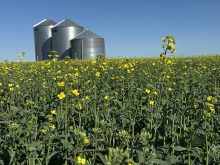Dale Adolphe says he left the Canola Council of Canada for the Canadian
Seed Growers Association so he could have a bit of change in his life.
While it’s a new job in a different city, the former canola council
president has seen little but momentous change in the years he spent in
the canola industry. He watched the crop mutate from a niche market
lubricant to the vegetable oil of choice for millions of consumers here
and overseas.
Read Also

Huge Black Sea flax crop to provide stiff competition
Russia and Kazakhstan harvested huge flax crops and will be providing stiff competition in China and the EU.
He has also seen the crop become a bulwark of prairie farm income.
Often it was farmers’ most profitable crop.
It wasn’t something Adolphe expected to happen when he started working
with the crop in Agriculture Canada’s production, planning and policy
group in the early 1970s.
He remembers a meeting of the Rapeseed Association of Canada in which
one speaker raised a question that many scoffed at: will we ever
produce 100 million bushels of rapeseed?
A few years ago prairie farmers produced 400 million bu. of canola.
“Almost everybody’s estimate of where the crop would expand to has been
grossly underestimated,” Adolphe said.
“I can’t think of any other example where a crop has changed and
expanded so much that it’s actually changed it’s name and become a big
success.”
Adolphe became directly involved with promoting the crop when he joined
the Rapeseed Association of Canada in 1978 as an agronomist. At the
time, rapeseed only grew on one or two million acres of the Prairies.
He moved to Winnipeg to join what is now called the Canola Council of
Canada, working as its market development co-ordinator.
The industry had pushed for change from industrial product to human
food, but was still trying to attract buyers for the novel crop.
Then in the early 1980s the United States government approved canola as
a food product. Acres, and the industry, took off. Markets opened,
consumption soared and farmers jumped into the crop. Adolphe was busy.
Crushers opened and expanded across the Prairies, bringing value-added
processing to the bulk export-oriented Prairies.
Adolphe became president in 1995.
Canola acres boomed in the mid-1990s as the crop gave farmers a far
better return than wheat. Canola briefly became the highest-value crop
grown on the Prairies, toppling King Wheat from its throne.
After years of radical change and expansion, the industry has settled
into a more stable form. Now it’s one of the institutions of prairie
agricultural production, joining the ranks of wheat, barley and beef.
Recently, because of bad prices and drought, acreage has slipped and
crushers have found they have too much capacity for the crop being
grown and the markets they’re allowed into.
“It might be said that it’s reached a bit of a plateau,” Adolphe said.
The crop has also been embroiled in controversy. It was one of the
first crops to be genetically modified and one of the first to suffer
market discrimination because of it.
Don Kerr of James Richardson International said successfully dealing
with the GM uproar has been one of Adolphe’s achievements.
“He led us in that very important issue and through a lot of the
hurdles we had, some of them potentially very damaging to our trade,”
Kerr said.
“Dale was the one who led us through that, and hopefully now it’s
largely behind us.”
Adolphe said he still sees the GM issue as the chief threat to the
canola industry, but it seems to have calmed down somewhat.
While acreage and production aren’t likely to exponentially increase as
they did in the past, Adolphe still sees hopeful signs that could bring
a market pull back to the industry.
Sales to China and Mexico have been enlarging the roster of canola’s
customers, which might eventually spur the industry.
“That provides the pull to expand,” he said.
Canola’s wild ride from niche market crop to mass production product
has brought high hopes, new opportunities and sometimes high anxieties.
It’s been an industry Adolphe has been happy to be at the centre of.
“It’s been exciting,” he said, a few weeks into his job as executive
director of the seed growers association.

















